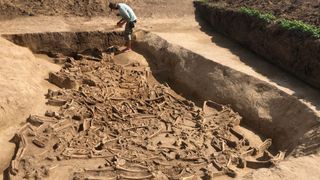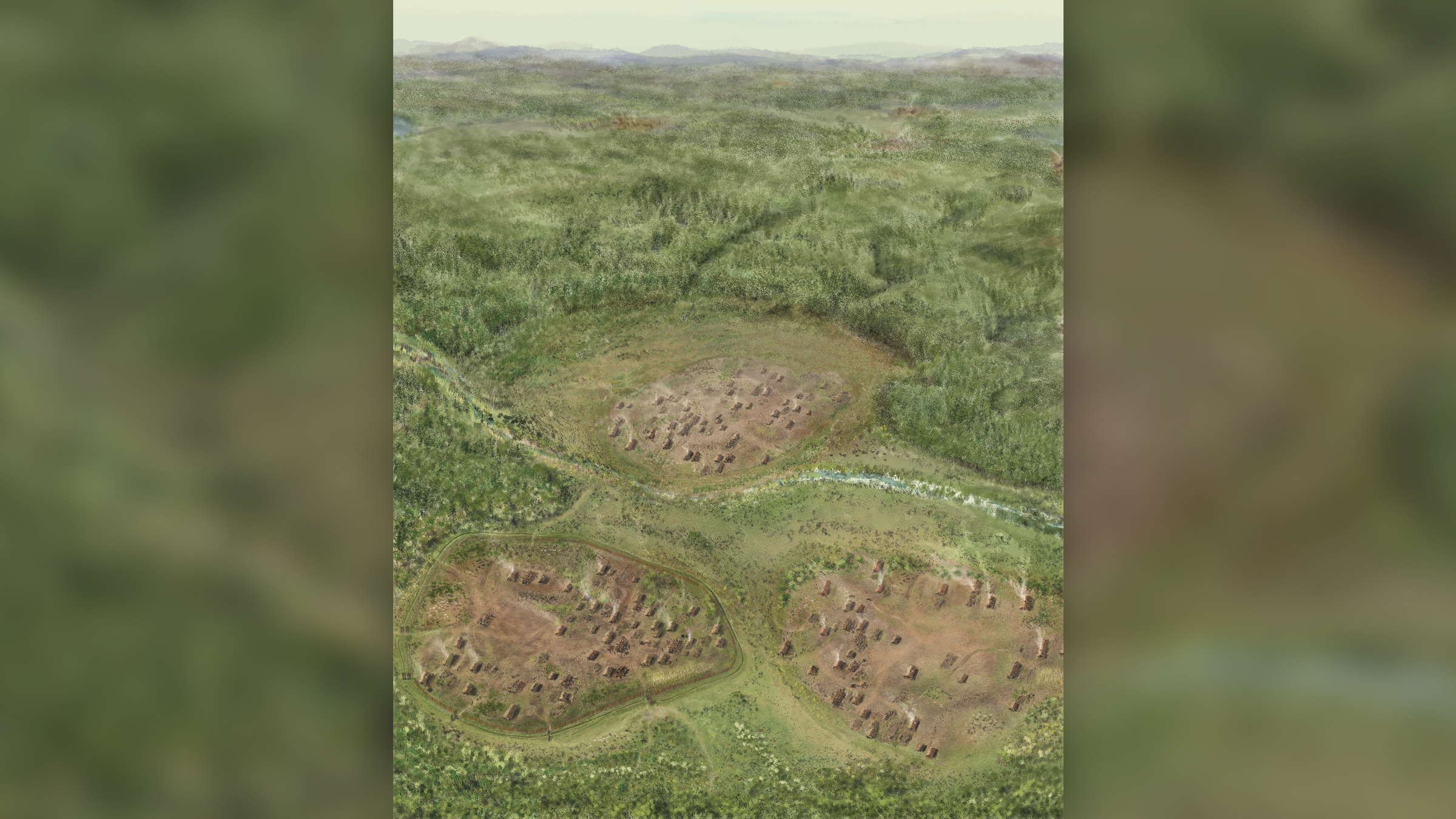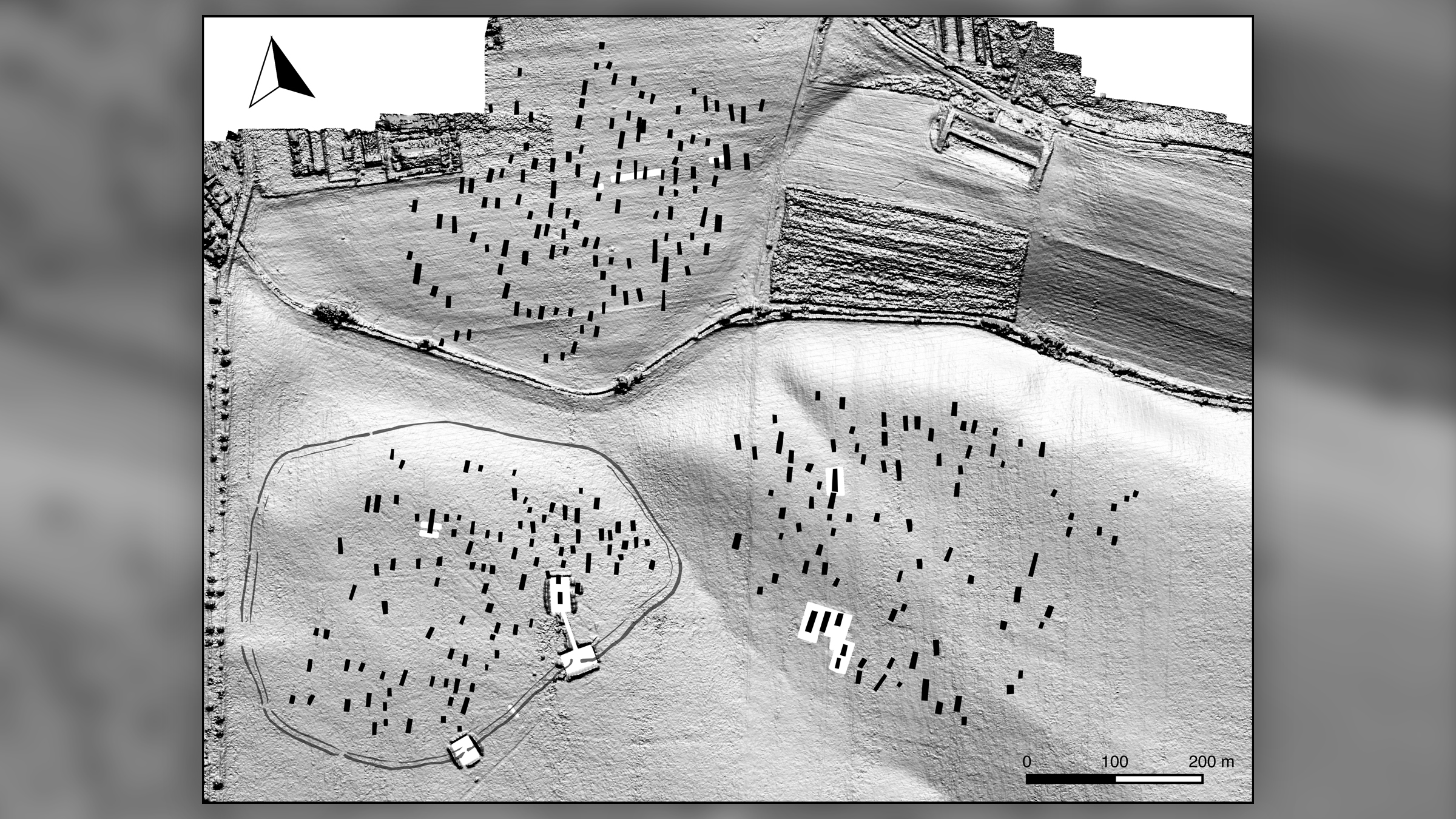The archaeologists have discovered about 35 skeletons, almost all missing their heads, in a mass grave that dates from about 5000 B.C. at Vráble in western Slovakia.

Archaeologists investigating an early Neolithic settlement in Slovakia have discovered the battered remains of about 35 people, many of them teenagers, who appear to have been decapitated and then thrown into a ditch almost 7,000 years ago.
The location of the grisly find this summer and the positions of the skeletons suggest the victims were dumped there on purpose, possibly as human sacrifices intended to magically strengthen a defensive wall built above the ditch, according to the researchers.
“I think it has something to do with magical ideas about how to define and fortify the settlement,” co-leader of the project Martin Furholt, a professor of protohistoric and social archaeology at Kiel University in Germany, told Live Science.
“We have a ditch around a site where people are living, and then you put people in the ditch — whether they were killed deliberately, or died of natural causes — because probably there were ideas about the magical or symbolic power that these [dead] people had,” he said.
Furholt and his colleagues at Kiel University — formally, the Christian-Albrecht University of Kiel — have worked since 2012 at the site at Vráble in Slovakia, near that country’s borders with Austria and Hungary, alongside scientists from the Institute of Archaeology of the Slovak Academy of Sciences (SAV).
The site is an ancient settlement attributed to the early Neolithic LBK culture, named after the German term “Linearbandkeramik,” which means “linear band ceramics” and refers to the type of pottery they made.
Furholt said the ancestors of the people at Vráble seem to have crossed into what’s now Greece from Anatolia (now Turkey) about 1,500 years earlier. The LBK culture spread from there to many parts of Europe, and they may have been the ancestors of the first Neolithic settlers in Western Europe who built megalithic structures such as Stonehenge in England and Carnac in France, he said.

The ancient settlement at Vráble is a major site for the archaeology of the early Neolithic LBK culture of central and southern Europe. Excavations show it was divided into three parts or “neighborhoods.” (Image credit: Painting by Karin Winter)
Human sacrifice
The ancient mass grave is near one of the entrances to the settlement at Vráble, and several aspects suggest the people dumped there were deliberately killed, possibly by decapitation.
“In the field, we have not recorded any clear signs of trauma or distinct pathological changes,” Zuzana Hukeľová, an anthropologist at the SAV involved with the excavation, told Live Science in an email. “Yet the bodies did not have skulls and we are still unsure how and when the heads have been removed.”
“[The] decapitation might have been one of the possible causes of death,” she said, adding that the researchers hope to learn more from the results of anthropological tests being conducted now.
The bodies lay in various positions — on their backs, on the sides, on their stomachs, or with the arms and legs widely spread and bent at the elbows and knees, “like a swimming frog,” Hukeľová said. “This is one of the positions indicating that the body was probably thrown into the pit.”
Most of the dead seem to have been young adults between 18 and 25 years old when they were killed, and some seem to have been between 25 and 35.
But there were no mature or elderly individuals, and there was only one infant, who was also the only person buried with their skull. “We will know better once the skeletons are analyzed,” she said.

Archaeologists have found traces of roughly 300 longhouses at Vráble,of which about 80 were inhibited it any one time. Each longhouse would have been the home of one or more extended families. (Image credit: Nils Müller-Scheeßel)
Ancient mystery
Furholt said the Neolithic settlement at Vráble consisted of up to 80 “longhouses” at any one time, with each longhouse being the home of one or more extended families.
The settlement was divided into three distinct neighborhoods, and it seemed that the defensive wall and ditch were built around just one neighborhood in the later stages of its occupation, which might have been an attempt to keep out people from the other neighborhoods.
Related: 15 people were brutally murdered 5,000 years ago, but the bodies were buried with care
“Only one of these neighborhoods gets this kind of fortification, and it has six entrances, but none of them connect this neighborhood to the others,” he said. “This makes us think that it wasn’t to defend against someone from the outside, but it was a kind of an internal division where they tried to block access to their neighbors.”
Christian Meyer, an archaeologist at the OsteoArchaeological Research Centre (OsteoARC) in Goslar, Germany, isn’t involved in the excavations at Vráble but has studied mass violence at other LBK sites (opens in new tab).
“Interpretations like massacres, executions, torture, mutilation and various cultic practices have been suggested,” he told Live Science in an email. “Given what is already known about this archaeological culture, the discovery of what seems to be another mass grave is not surprising in itself.”
An unusual feature of the mass grave at Vráble was that the people buried there were missing their heads. This “seems to be most striking and is likely of profound significance,” Meyer said, adding that it warrants further explanation.
“This site will advance our knowledge about social interactions and the treatment of the living and the dead during these times, many thousand years in the past,” he said.





